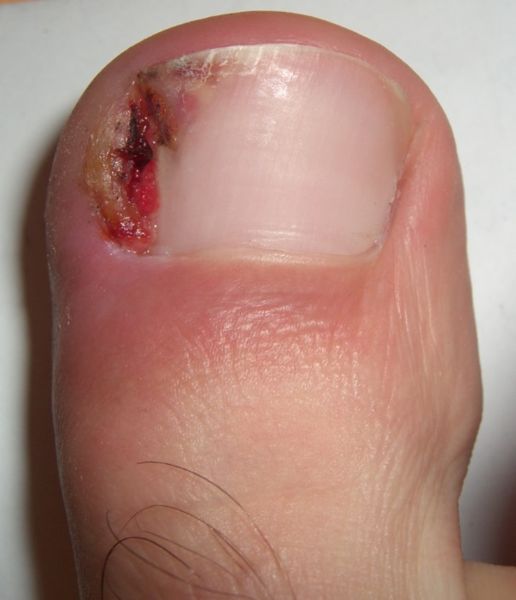|
|
| Line 13: |
Line 13: |
| {{SK}} Ingrown toenails; ingrowing nails; ingrown nails; unguis incarnatus | | {{SK}} Ingrown toenails; ingrowing nails; ingrown nails; unguis incarnatus |
|
| |
|
| ==Treatment==
| |
| Treatment of ingrown nails ranges from soaking the afflicted area to surgery. The appropriate method is dictated by the severity of the condition. In nearly all cases, drainage of blood or watery discharge should mean a trip to the doctor, usually a [[podiatrist]], a specialist trained explicitly to treat these conditions. Most practitioners agree that trying to ''outwait'' the condition is nearly always fruitless, as well as agonizing.
| |
|
| |
| ===Pharmacotherapy===
| |
|
| |
| ====Acute Pharmacotherapies====
| |
|
| |
| When the case of an ingrown nail is not severe, there are treatments that can be completed at home without a doctor's help. In mild cases doctors recommend daily soaking of the afflicted digit in a mixture of warm water and [[Epsom salts]] and applying an [[Over-the-counter drug|over-the-counter]] [[antiseptic]]. This might allow the nail to grow out so it may be trimmed properly and the flesh to heal. A simple yet extremely painful procedure for mild ingrowth (i.e., where infection is absent) requires small scissors to trim the nail completely along the nail margin down to the lateral base. This hopefully allows the embedded piece of nail to be pushed back and out from the toe tissue. It should be noted that infection may be somewhat difficult to prevent in cleaning and treating ingrown nails owing to the warm, dark, and damp environment in shoes. [[Peroxide]] is immediately effective to help clean minor infections but [[iodine]] is more effective in the long term as it continues to prevent bacterial growth even after it is dry. Iodine should not be used on deep wounds. In such cases a physician or podiatrist should be consulted. Also, bandages can help keep out bacteria but one should ''never'' apply any of the new types of spray-on bandages to ingrown nails that show any discharge - preventing drainage will likely cause intense swelling and pain.
| |
|
| |
| It is also advisable to walk around barefoot so that air has a chance to circulate. Infections often become more painful when they are not exposed to air because bacteria grows more quickly in warmer conditions such as when the foot is impacted tightly in a shoe.
| |
|
| |
| These home remedies are, in serious cases, ineffective: when the flesh is far too swollen and infected, it will not allow for these procedures to work. Thus, these more severe cases, such as when the area around the nail becomes infected or the nail will not grow back properly, must be treated by a professional and the patient should avoid repeated attempts at this type of 'bathroom surgery.'
| |
|
| |
| ====Chronic Pharmacotherapies====
| |
|
| |
| For long term treatment, [[Iodine]] would be the more effective treatment. Iodine continues to prevent bacterial growth even after it has dried.
| |
| ==References== | | ==References== |
| {{Reflist|2}} | | {{Reflist|2}} |
